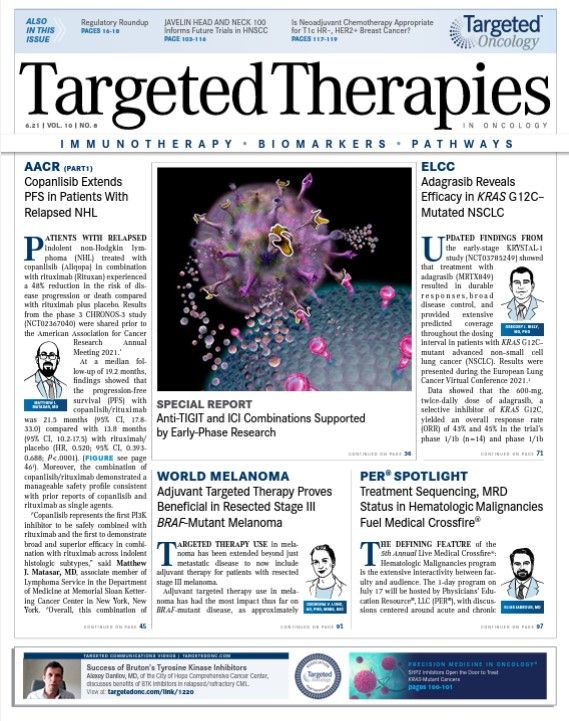Underused Next-Generation Sequence Testing Revealed in MYLUNG Consortium Study
Results from the first phase of the broad, collaborative MYLUNG research study in lung cancer provide a close-up look at current biomarker testing rates and turnaround times for patients treated in community practices within The US Oncology Network.
Robert L. Coleman, MD

Results from the first phase of the broad, collaborative MYLUNG research study in lung cancer are now available. Recently presented during the lung cancer session at the 2021 American Society of Clinical Oncology Annual Meeting, the findings provide a close-up look at current biomarker testing rates and turnaround times for patients treated in community practices within The US Oncology Network (The Network). MYLUNG—or Molecularly Informed Lung Cancer Treatment in a Community Cancer Network: A Pragmatic Consortium (MYLUNG Consortium)—is a national, real-world 3-phase evidence study of more than 12,000 patients with metastatic non-small cell lung cancer (NSCLC) over a 5-year period. The MYLUNG consortium unites providers and investigators in The Network, US Oncology Research, and Ontada with biopharmaceutical manufacturers and patient advocacy groups. These diverse organizations and stakeholders across NSCLC drug development, therapy, and care are collaborating in a joint effort to advance precision medicine for lung cancer.
Sarah A. Alwardt, PhD

MYLUNG Consortium consists of 3 protocols, and each will provide valuable information over the course of the study and well beyond, as the data will continue to be mined for many years. Protocol 1, which just concluded, examines Ontada’s real-world data from electronic health records to identify trends such as testing rates, types of tests selected, and other practice patterns, laying the groundwork for the next 2 study protocols. Protocol 2 will observe factors and events that determine a patient’s first-line treatment selection, and protocol 3 will connect the findings from the first 2 protocols to enable prospective, operational interventions. The hope is that MYLUNG Consortium will fill the gap between developments in emerging targeted therapies and the knowledge present at the physician/patient level in order to match therapies to tumor findings. This article, the second in a series following the MYLUNG Consortium study, takes a close look at protocol 1 results.
Protocol 1 Reveals Baseline Trends
Protocol 1 provides a close-up lens into NSCLC biomarker testing practices over the past few years. During this retrospective study of more than 3500 patients with metastatic NSCLC, the following areas were investigated: testing rates for ALK, BRAF, EGFR, ROS1 mutations, and PD-L1; use of a full next-generation sequencing (NGS) panel; time from NSCLC diagnosis to first-line therapy; turnaround times from biomarker orders to results; and time from NSCLC diagnosis to test results.
The analysis of this in-depth data enables the formation of some early conclusions about historical baseline trends for testing patterns, such as:
- Most patients are receiving some biomarker testing.
Approximately 90% of patients have at least 1 biomarker test prior to first-line therapy. This high number is encouraging because almost all patients are undergoing testing.
- Less than half of the patients had 5 or more biomarkers tested.
Only 46% received 5 or more biomarker tests, potentially leaving many biomarkers unidentified that may be useful in making treatment decisions.
- NGS occurs in less than 50% of patients.
Although NGS testing increased over the periods examined, it is still vastly underutilized. This is concerning because the goal of targeted therapy is to ensure that providers are adapting treatments to all the potential biomarkers that have been identified. Failing to employ this valuable tool whenever possible limits the knowledge that can play a key role in determining the most effective and appropriate therapy for a specific cancer.
- Time from diagnosis to first-line therapy is 5 weeks.
Five weeks is a long time to wait for treatment for distressed and anxious patients with an aggressive advanced cancer. This delay may be a driving factor in the initiation of nontargeted therapy that is then eventually switched to a more targeted treatment.
- Time to obtain biomarker testing results is prolonged.
The median turnaround time from biomarker testing orders to results ranged from 10 to 15 days for individual biomarkers, and time from diagnosis to biomarker results ranged from 14 to 21 days by biomarker. The median time from diagnosis to first-line therapy for all patients was 35 days.
The time taken to get test results and the time to treatment highlight what the MYLUNG Consortium gap analysis is trying to address and impact. By identifying why there is such a delay in getting test results and where there is opportunity to improve the testing process, it may be possible to get information in front of the patient and physician earlier.
- Demographic trends are as expected.
Most of the population is receiving a diagnosis at advanced disease, with roughly more than 80% diagnosed at stage IV; portions of the population are receiving a diagnosis at earlier stages and then progress into an advanced disease state. Testing is occurring when appropriate at advanced disease. No age groups are overly represented or misrepresented.
These results are consistent with the trends in NSCLC across the nation from an epidemiological perspective.
Protocol 1 Provides a Foundation for Further Exploration
By examining current testing practices in protocol 1, valuable data were gained. To determine how to improve treatment assignment in the future, it is imperative to know how things are today. Protocol 1 provided that information through careful interrogation of the data. Collecting retrospective data, such as in protocol 1, can encourage hypothesis generation. These studies shine a light on current practices but do not change how things are done. That requires additional steps. Protocol 1 identified various data gaps and enabled the formation of some interesting conclusions and hypotheses to address in forthcoming prospective trials. There is much more to come, and we hope the cancer care community will stay with us on this journey.
The next phase of the MYLUNG Consortium study, protocol 2, is now underway and will provide a more granular understanding of the tissue journey by prospectively evaluating contemporary ordering practices and testing turnaround times. Protocol 1 results are also driving some early thoughts about interventions that can be investigated in protocol 3. We are excited to have the opportunity to explore these theories because all this research contributes to the development of strategies to optimize care in the future.
